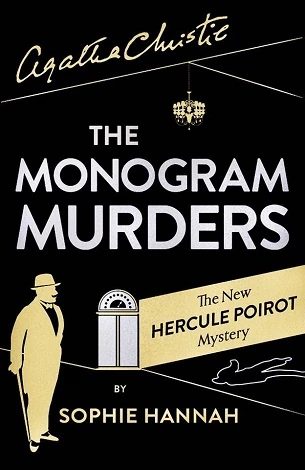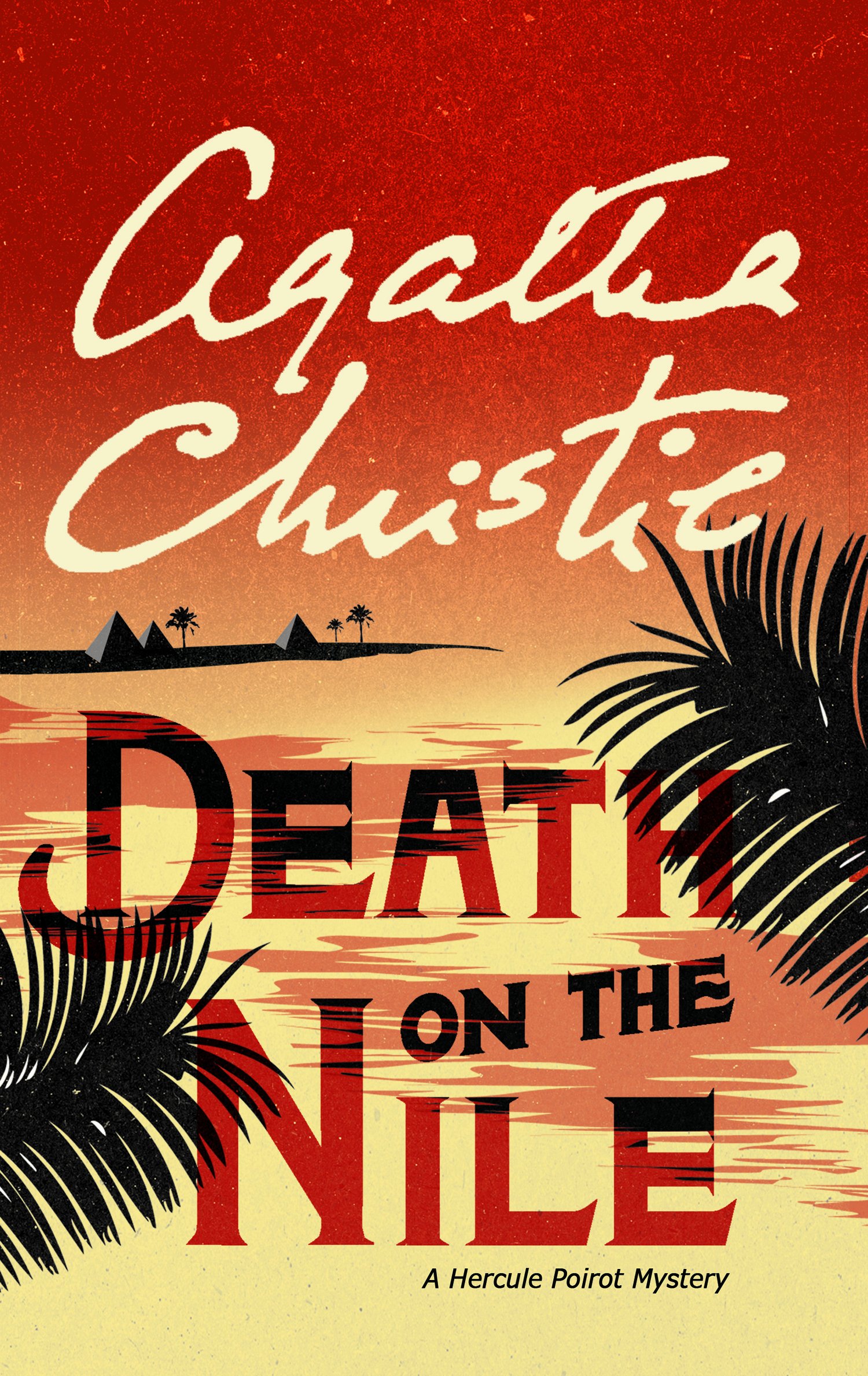The first books that come to mind are Jon Scieszka'a hilarious riffs on fairy tales and fables.
Probably the most popular of these is The True Story of the 3 Little Pigs! by A. Wolf As told to Jon Scieszka and illustrated by Lane Smith. This is Alexander T. Wolf's side of the story and it turns out that this whole big and bad thing is a complete misunderstanding. All he wanted was to borrow a cup of sugar from his neighbors so he could bake a cake for his granny. Unfortunately, Mr. Wolf happened to have a terrible cold that day and kept sneezing down the little pigs' houses. It wasn't his fault that two unintelligent little pigs made their house out of straw and sticks. Of course, Mr. Wolf did lose his temper when the third little pig in the brick house insulted his dear old granny, but who could blame him?
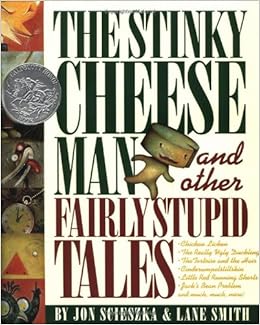 Two other collaborations by Jon Scieszka and Lane Smith are The Stinky Cheese Man and other Fairly Stupid Tales, which was a Caldecott Honor book in 1993, and Squids will be Squids: Fresh Morals, Beastly Tales.
Two other collaborations by Jon Scieszka and Lane Smith are The Stinky Cheese Man and other Fairly Stupid Tales, which was a Caldecott Honor book in 1993, and Squids will be Squids: Fresh Morals, Beastly Tales.  The former of these is a series of ridiculous parodies of fairy tales all narrated by Jack from Jack and the Beanstalk. Instead of Little Red Riding Hood there is Little Red Running Shorts, The Gingerbread Man is replaced by The Stinky Cheese Man, and we have The Really Ugly Duckling who does not grow up to a be a beautiful Swan.
The former of these is a series of ridiculous parodies of fairy tales all narrated by Jack from Jack and the Beanstalk. Instead of Little Red Riding Hood there is Little Red Running Shorts, The Gingerbread Man is replaced by The Stinky Cheese Man, and we have The Really Ugly Duckling who does not grow up to a be a beautiful Swan.
 In Squids will be Squids Scieszka and Smith take on Aesop's fables and the results are hysterical. If you are an adult that is easily offended by juvenile humor you might want to leave this book on the shelf. Kids will crack up, though, at morals like: He who smelt it, dealt it.
In Squids will be Squids Scieszka and Smith take on Aesop's fables and the results are hysterical. If you are an adult that is easily offended by juvenile humor you might want to leave this book on the shelf. Kids will crack up, though, at morals like: He who smelt it, dealt it.
Scieszka also wrote The Frog Prince Continued which features stunning yet slightly dark and sinister paintings by Steve Johnson. After the princess kissed the frog and turned him into a handsome prince they lived happily ever after. At least that is the way the story goes, but according to this sequel the couple haven't quite settled down to marital bliss. The princess is constantly irritated that the prince continues to behave like a frog and the prince decides that his life was better before he became human. Now all he has to do is find a witch that will turn him back into a frog.
 |
| Do you see pigeon? |

There are countless versions of Goldilocks and the Three Bears, but my absolute favorite is Goldilocks and the Three Dinosaurs by Mo Willems. My youngest son loooovvveedddd this book and we read it together more times than I can count. If you are a fan of Mo Willems other children's books, you will also enjoy looking for the hidden pictures of pigeon throughout Goldilocks and the Three Dinosaurs.
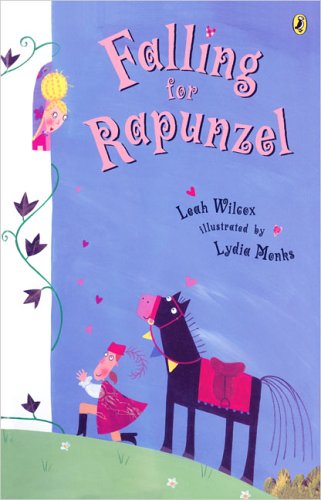
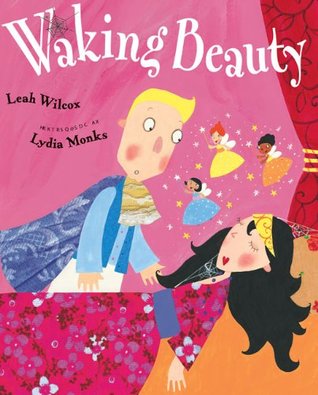 I am not one for perfect, pretty princess stories, which is probably why I adore Falling for Rapunzel and Waking Beauty by Leah Wilcox. The poor tower-bound princess in Falling for Rapunzel cannot understand what the prince is asking and throws everything but her hair out the window. Rather than silky tresses Rapunzel tosses out some silky dresses. Asking for curly locks gets the prince covered in dirty socks and, of course, hair is misinterpreted as underwear.
I am not one for perfect, pretty princess stories, which is probably why I adore Falling for Rapunzel and Waking Beauty by Leah Wilcox. The poor tower-bound princess in Falling for Rapunzel cannot understand what the prince is asking and throws everything but her hair out the window. Rather than silky tresses Rapunzel tosses out some silky dresses. Asking for curly locks gets the prince covered in dirty socks and, of course, hair is misinterpreted as underwear.In Waking Beauty the three fairies try to tell Prince Charming how to awaken the sleeping princess, but he keeps interrupting with his own ideas. When he finally learns that he has to kiss Sleeping Beauty, the prince is not too sure. After all, hasn't he heard that girls have germs?
Adult, child, boy, girl. Every reader will be laughing out loud at Wilcox's farcical versions of these classic princess stories.
 Okay, back to the beginning with two more unique versions of The Three Little Pigs. The first of these, The Three Pigs by the incomparable David Wiesner, was awarded the Caldecott Medal in 2002. The story may start off familiarly with three little pigs gathering straw, sticks, and bricks to build houses. Wiesner's version veers from the classic Grimm fairy tale, though, when the big, bad wolf huffs and puffs the first little pig right off the page of the book. Soon all three of the pigs have escaped the pages of their book and set out to explore other stories.
Okay, back to the beginning with two more unique versions of The Three Little Pigs. The first of these, The Three Pigs by the incomparable David Wiesner, was awarded the Caldecott Medal in 2002. The story may start off familiarly with three little pigs gathering straw, sticks, and bricks to build houses. Wiesner's version veers from the classic Grimm fairy tale, though, when the big, bad wolf huffs and puffs the first little pig right off the page of the book. Soon all three of the pigs have escaped the pages of their book and set out to explore other stories. |
| From Tuesday |
 The Three Ninja Pigs by Corey Rosen Schwartz and illustrated by Dan Santat is wonderfully silly and fun to read. In order to combat the big bad wolf three porcine siblings sign up for martial arts lessons. As in the original fairy tale, two of the pigs are lazy and want to play, whereas the third little pig (the sister because girls are just smarter) works hard. Well, big surprise as to who has the ninja skills to defeat the wolf when he shows up in town. Afterwards, the brothers decide to follow their sister's example and put forth the effort to earn their black belts.
The Three Ninja Pigs by Corey Rosen Schwartz and illustrated by Dan Santat is wonderfully silly and fun to read. In order to combat the big bad wolf three porcine siblings sign up for martial arts lessons. As in the original fairy tale, two of the pigs are lazy and want to play, whereas the third little pig (the sister because girls are just smarter) works hard. Well, big surprise as to who has the ninja skills to defeat the wolf when he shows up in town. Afterwards, the brothers decide to follow their sister's example and put forth the effort to earn their black belts.
 Schwartz and Santat collaborated again on Ninja Red Riding Hood, which is a companion to The Three Ninja Pigs. With the three ninja pigs around the big bad wolf can no longer huff and puff his way to an easy meal. Hunger sends the wolf to a dojo to master the martial arts. Who better to test out his new karate skills on then a little girl and her granny? Well, unfortunately for the wolf Red Riding Hood has some butt-kicking ability of her own.
Schwartz and Santat collaborated again on Ninja Red Riding Hood, which is a companion to The Three Ninja Pigs. With the three ninja pigs around the big bad wolf can no longer huff and puff his way to an easy meal. Hunger sends the wolf to a dojo to master the martial arts. Who better to test out his new karate skills on then a little girl and her granny? Well, unfortunately for the wolf Red Riding Hood has some butt-kicking ability of her own.Fans of The Three Ninja Pigs and Ninja Red Riding Hood will be thrilled to hear that a third book, Hensel and Gretel: Ninja Chicks, comes out later this month.

